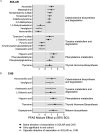Metabolic Signatures of Youth Exposure to Mixtures of Per- and Polyfluoroalkyl Substances: A Multi-Cohort Study
- PMID: 36821578
- PMCID: PMC9945578
- DOI: 10.1289/EHP11372
Metabolic Signatures of Youth Exposure to Mixtures of Per- and Polyfluoroalkyl Substances: A Multi-Cohort Study
Abstract
Background: Exposure to per- and polyfluoroalkyl substances (PFAS) is ubiquitous and has been associated with an increased risk of several cardiometabolic diseases. However, the metabolic pathways linking PFAS exposure and human disease are unclear.
Objective: We examined associations of PFAS mixtures with alterations in metabolic pathways in independent cohorts of adolescents and young adults.
Methods: Three hundred twelve overweight/obese adolescents from the Study of Latino Adolescents at Risk (SOLAR) and 137 young adults from the Southern California Children's Health Study (CHS) were included in the analysis. Plasma PFAS and the metabolome were determined using liquid-chromatography/high-resolution mass spectrometry. A metabolome-wide association study was performed on log-transformed metabolites using Bayesian regression with a g-prior specification and g-computation for modeling exposure mixtures to estimate the impact of exposure to a mixture of six ubiquitous PFAS (PFOS, PFHxS, PFHpS, PFOA, PFNA, and PFDA). Pathway enrichment analysis was performed using Mummichog and Gene Set Enrichment Analysis. Significance across cohorts was determined using weighted -tests.
Results: In the SOLAR and CHS cohorts, PFAS exposure was associated with alterations in tyrosine metabolism (meta-analysis ) and de novo fatty acid biosynthesis (), among others. For example, when increasing all PFAS in the mixture from low (th percentile) to high (th percentile), thyroxine (T4), a thyroid hormone related to tyrosine metabolism, increased by 0.72 standard deviations (SDs; equivalent to a standardized mean difference) in the SOLAR cohort (95% Bayesian credible interval (BCI): 0.00, 1.20) and 1.60 SD in the CHS cohort (95% BCI: 0.39, 2.80). Similarly, when going from low to high PFAS exposure, arachidonic acid increased by 0.81 SD in the SOLAR cohort (95% BCI: 0.37, 1.30) and 0.67 SD in the CHS cohort (95% BCI: 0.00, 1.50). In general, no individual PFAS appeared to drive the observed associations.
Discussion: Exposure to PFAS is associated with alterations in amino acid metabolism and lipid metabolism in adolescents and young adults. https://doi.org/10.1289/EHP11372.
Figures





References
-
- Sunderland EM, Hu XC, Dassuncao C, Tokranov AK, Wagner CC, Allen JG. 2019. A review of the pathways of human exposure to poly- and perfluoroalkyl substances (PFASs) and present understanding of health effects. J Expo Sci Environ Epidemiol 29(2):131–147, PMID: , 10.1038/s41370-018-0094-1. - DOI - PMC - PubMed
-
- Whitehead HD, Venier M, Wu Y, Eastman E, Urbanik S, Diamond ML, et al. . 2021. Fluorinated compounds in North American cosmetics. Environ Sci Technol Lett 8(7):538–544, 10.1021/acs.estlett.1c00240. - DOI
-
- Andrews DQ, Naidenko OV. 2020. Population-wide exposure to per- and polyfluoroalkyl substances from drinking water in the United States. Environ Sci Technol Lett 7(12):931–936, 10.1021/acs.estlett.0c00713. - DOI
Publication types
MeSH terms
Substances
Grants and funding
- U2C ES030163/ES/NIEHS NIH HHS/United States
- P50 MD017344/MD/NIMHD NIH HHS/United States
- R21 ES029681/ES/NIEHS NIH HHS/United States
- P01 ES022845/ES/NIEHS NIH HHS/United States
- R01 ES030691/ES/NIEHS NIH HHS/United States
- R01 DK059211/DK/NIDDK NIH HHS/United States
- R21 ES028903/ES/NIEHS NIH HHS/United States
- R01 ES032831/ES/NIEHS NIH HHS/United States
- P01 ES011627/ES/NIEHS NIH HHS/United States
- R00 ES027870/ES/NIEHS NIH HHS/United States
- T32 ES013678/ES/NIEHS NIH HHS/United States
- P30 ES019776/ES/NIEHS NIH HHS/United States
- K12 ES033594/ES/NIEHS NIH HHS/United States
- R21 ES031824/ES/NIEHS NIH HHS/United States
- R01 ES029944/ES/NIEHS NIH HHS/United States
- P30 ES007048/ES/NIEHS NIH HHS/United States
- R21 ES029328/ES/NIEHS NIH HHS/United States
- R25 GM143298/GM/NIGMS NIH HHS/United States
- P30 ES023515/ES/NIEHS NIH HHS/United States
- R01 ES032189/ES/NIEHS NIH HHS/United States
- U2C ES030859/ES/NIEHS NIH HHS/United States
- R01 ES030364/ES/NIEHS NIH HHS/United States
- R24 ES029490/ES/NIEHS NIH HHS/United States
- P01 CA196569/CA/NCI NIH HHS/United States
- R01 ES033688/ES/NIEHS NIH HHS/United States
- R00 ES027853/ES/NIEHS NIH HHS/United States
LinkOut - more resources
Full Text Sources
Research Materials

